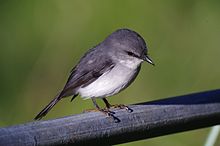白胸鸲鹟
白胸鸲鹟(学名:Quoyornis georgianus)是一种属于鸲鹟科的鸟纲动物。白胸鸲鹟是西澳大利亚州西南部分独有的品种。与许多其他澳大利亚鸲鹟不同,它们身上没有颜色鲜艳的羽毛,仅有一些灰色羽毛,以及位于腹部的白色羽毛。白胸鸲鹟与澳大利亚其他雀形动物的相似之处,就是当一对或一群白胸鸲鹟找到定居点后,他们便会保卫自己的家园。
| 白胸鸲鹟 | |
|---|---|

| |
| 白胸鸲鹟,摄于西澳大利亚。 | |
| 科学分类 | |
| 界: | 动物界 Animalia |
| 门: | 脊索动物门 Chordata |
| 纲: | 鸟纲 Aves |
| 目: | 雀形目 Passeriformes |
| 科: | 鸲鹟科 Petroicidae |
| 属: | 白胸鸲鹟属 Quoyornis Mathews, 1912 |
| 种: | 白胸鸲鹟 Q. georgianus
|
| 二名法 | |
| Quoyornis georgianus | |
| 异名[2] | |
|
Muscicapa georgiana Quoy & Gaimard, 1830 | |
分类
编辑法国博物学家吉恩勒内·康斯坦槐奥和约瑟夫·保罗·盖马尔于1830年首次为白胸鸲鹟起了学名“Muscicapa georgiana”。[3]于1846年,约翰·古尔德将白胸鸲鹟重新命名为“Eopsaltria leucogaster”。[4]而现今的学名是以1846年的Eopsaltria以及1830年的georgiana组合而成。
白胸鸲鹟与欧亚鸲或美国知更鸟的关系不大。白胸鸲鹟属于鸲鹟属,并在澳洲被分类为“黄知更”,以与同为鸲鹟属的“红知更”分开。白胸鸲鹟亦被称为白腹鸲鹟或白胸伯劳知更鸟。[5]
在一个于2009年进行的核与线粒体DNA的遗传分析研究中,科学家意外地发现白胸鸲鹟与澳洲大陆东北部的鸲鹟是姐妹群。[6]
描述
编辑白胸鸲鹟身长约14.5厘米。雄性和雌性的羽毛颜色相近,上半身的颜色为蓝灰色,眉毛的颜色稍淡,而腹部的颜色则为白色。白胸鸲鹟灰色的尾巴末端颜色为白色,其喙及脚均为黑色,而其眼睛则为茶色。在澳洲北方的白胸鸲鹟体形较小,颜色亦更深色。而雏鸟的羽毛则为棕色。[7]
分布及栖息地
编辑白胸鸲鹟居住于西澳大利亚州由杰洛顿南方到露纹角之间的一大片区域。在这片区域的南部,白胸鸲鹟通常会居住于位于河流附近的森林。而在这片区域的北部,白胸鸲鹟则多出现于沿海地区。[7]当一对或一群白胸鸲鹟找到定居点后,他们便会保卫自己的家园。
习性
编辑白胸鸲鹟是合作繁殖动物。当一对白胸鸲鹟在繁殖时,在它们旁边会有一个或以上的鸲鹟帮助它们照顾雏鸟,[8]而帮助照顾雏鸟的鸲鹟皆为雄性。雌鸟会在繁殖一年后离开雄性,而雄性则会继续居住于其定居点。[8]
繁殖
编辑由冬季后期至夏季早期是白胸鸲鹟的繁殖期。白胸鸲鹟的巢是由干草和树枝组成的。在一对白胸鸲鹟的巢中,最多会有两只雏鸟居住。[9]白胸鸲鹟的蛋颜色为橄榄绿或蓝绿色,而蛋的大小约为16毫米x21毫米大。[10]这些蛋的孵化为期16至17天,而雏鸟会在孵化两个星期后离开鸟巢。[8]
参考文献
编辑- ^ BirdLife International. Eopsaltria georgiana. The IUCN Red List of Threatened Species. 2012 [26 November 2013].
- ^ Australian Biological Resources Study. Species Eopsaltria (Quoyornis) georgiana (Quoy & Gaimard, 1830). Australian Faunal Directory. Department of the Environment, Water, Heritage and the Arts, Australian Government. 12 June 2010 [19 June 2019].
- ^ Quoy, J.R.C. & Gaimard, J.P. in Dumont-d'Urville, J. (1830). Voyage de découvertes de l'Astrolabe exécuté par ordre du Roi, pendant les anneés 1826-1827-1828-1829, sous le commandement de M.J. Dumont-d'Urville. Zoologie. Paris: J. Tastu Vol. 1
- ^ Gould J. Descriptions of eleven new species of Australian birds. Proc. Zool. Soc. Lond. 1846: 18–21.
- ^ Boles, Walter E. The Robins and Flycatchers of Australia. Sydney: Angus & Robertson. 1988: 119. ISBN 0-207-15400-7.
- ^ Loynes, Kate; Joseph, Leo; Keogh, J. Scott. Multi-locus phylogeny clarifies the systematics of the Australo-Papuan robins (Family Petroicidae, Passeriformes). Molecular Phylogenetics and Evolution. 2009, 53 (1): 212–19. doi:10.1016/j.ympev.2009.05.012.
- ^ 7.0 7.1 Simpson K, Day N, Trusler P. Field Guide to the Birds of Australia. Ringwood, Victoria: Viking O'Neil. 1993: 392. ISBN 0-670-90478-3.
- ^ 8.0 8.1 8.2 Russell EM, Brown RJ, Brown MN. Life history of the white-breasted robin, Eopsaltria georgiana (Petroicidae), in south-western Australia. Australian journal of zoology. 2004, 52 (2): 111–45. doi:10.1071/ZO03049.
- ^ Cooney SJN, Watson DM, Young J. Mistletoe nesting in Australian birds: a review (PDF). Emu (CSIRO Publishing). 2006, 106: 1–12 [2007-06-07]. doi:10.1071/MU04018. (原始内容存档 (PDF)于2009-10-14).
- ^ Beruldsen, G. Australian Birds: Their Nests and Eggs. Kenmore Hills, Qld: self. 2003: 336–37. ISBN 0-646-42798-9.
